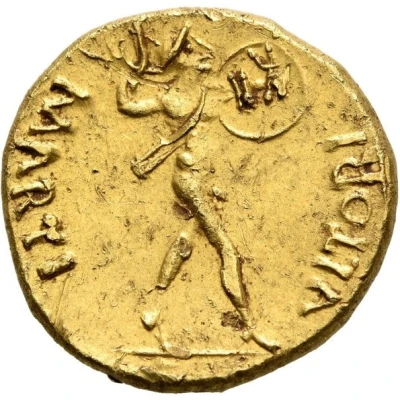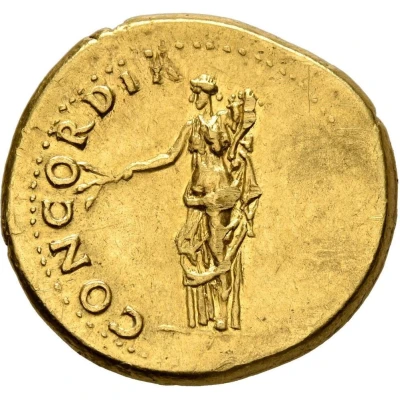


© Leu Numismatik
Aureus MARTI VLTORI; Genius and Mars
| Gold | 7.39 g | 18 mm |
| Issuer | Rome › Roman Empire (27 BC - 395 AD) |
|---|---|
| Period | Civil War (68-69) |
| Type | Standard circulation coin |
| Years | 68-69 |
| Value | 1 Aureus = 25 Denarii |
| Currency | Denarius, Reform of Augustus (27 BC – AD 215) |
| Composition | Gold |
| Weight | 7.39 g |
| Diameter | 18 mm |
| Shape | Round (irregular) |
| Technique | Hammered |
| Orientation | Variable alignment ↺ |
| Demonetized | Yes |
| Updated | 2024-10-05 |
| Numista | N#384741 |
|---|---|
| Rarity index | 100% |
Reverse
Mars advancing right, wearing only helmet, holding javelin in right hand, round shield in left; left, parazonium.
Script: Latin
Lettering: MARTI VLTORI
Unabridged legend: Marti Ultori
Translation: To Mars, the avenger
Comment
Forces of Galba in Spain. Anonymous, 3 April-2nd half of June 68.Only two known specimens.
The appearance of this aureus illustrates how much still remains to be discovered in the anonymous coinage of the civil war of 68-69. Known in silver only prior to the publication of the Gollnow collection, our example was struck from the same dies as a denarius in a private collection in Madrid (Nicolas pl. X, 33 RC) and thus shows that the crudely crafted dies were used for both gold and silver coins. Such die sharing between aurei and denarii is not unheard of in the 1st century AD and comes as no surprise in a time of crisis such as Galba's revolt in the spring of 68, when Galba's Spanish mint, being set up quickly, lacked experienced workers and used every opportunity to speed up the striking of coins (for another aureus struck from dies made for denarii, see Gollnow & Rutten 1009). It is worth noting that the obverse die of the present aureus was clearly crafted from the same die cutter as Gollnow & Rutten 1001, thus connecting it to Galba's EID MAR imitation. These coins form part of a group of anonymous coins of somewhat crude but very distinct style (note, in particular, the prominent staring eye), which have been labelled 'Group I' in the Gollnow & Rutten catalogue (lots 1001-4).
The types on this aureus are indicative of Galba's early propaganda, praising both the genius of the Roman people as well as Mars Ultor, the avenging Mars, whose worship had particularly been promoted by Augustus. Much like the coins struck in the name of the first princeps (see Gollnow & Rutten 1042-57, 1152-4 and 1175), the appearance of Mars Ultor on the reverse of Galba's early anonymous coinage connects the revolt to Augustus, while also publicly proclaiming that the rebellion was started to revenge those who have been suppressed by the tyrant - that is, of course, Nero.
Interesting fact
One interesting fact about this coin is that it features a unique combination of imagery and inscriptions that reflect the political and cultural values of the Roman Empire during the reign of Emperor Vespasian (69-79 AD). The obverse side of the coin depicts the emperor's portrait, while the reverse side shows the god Mars standing between the Genius (spirit) of the Roman people and the goddess Victory. The inscription "MARTI VLTORI" means "To Mars the Victor" in Latin, highlighting the Roman Empire's military prowess and the god Mars' association with war and victory. The coin's gold content and intricate design also symbolize the wealth and power of the Roman Empire during this period.

